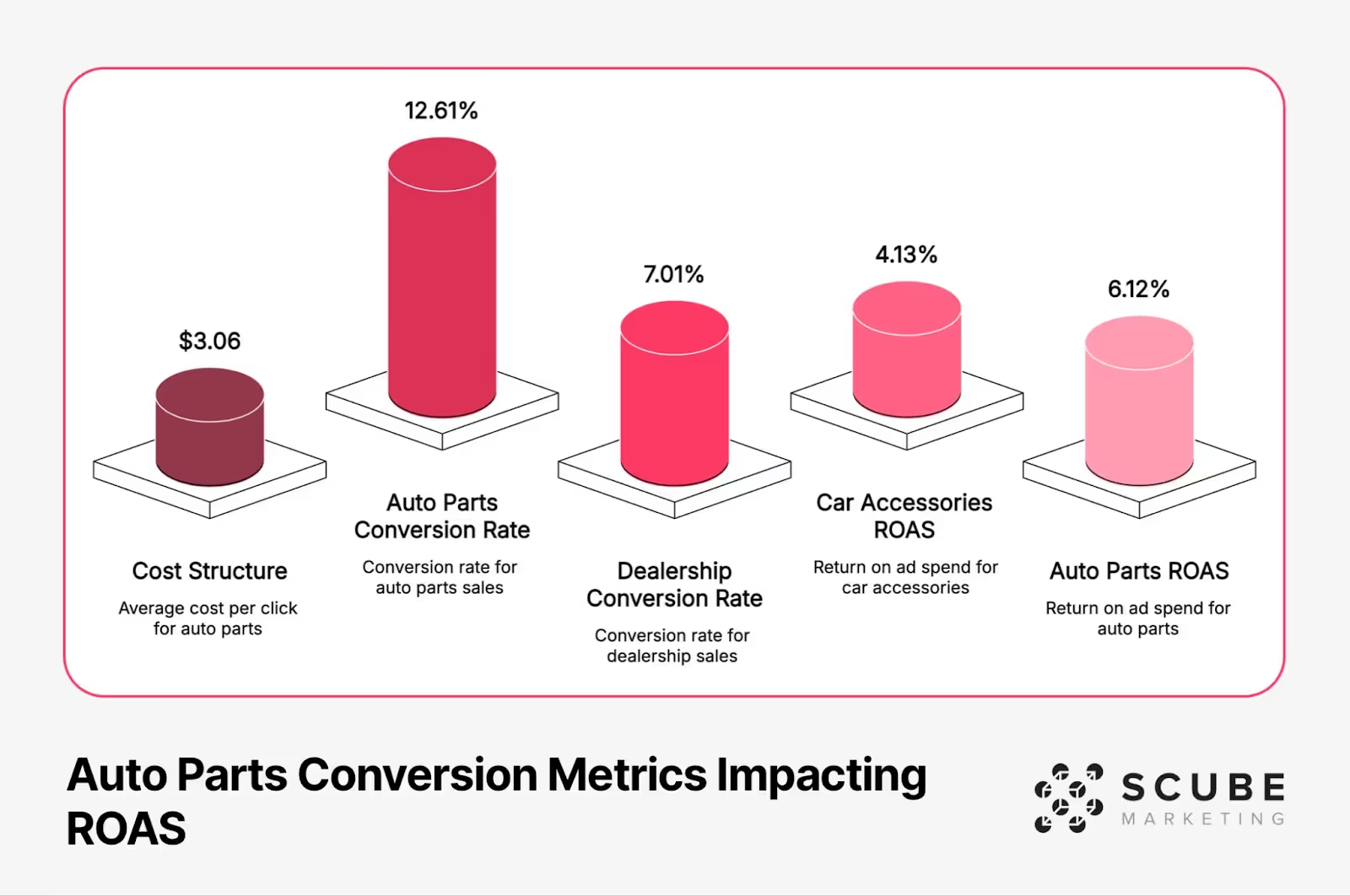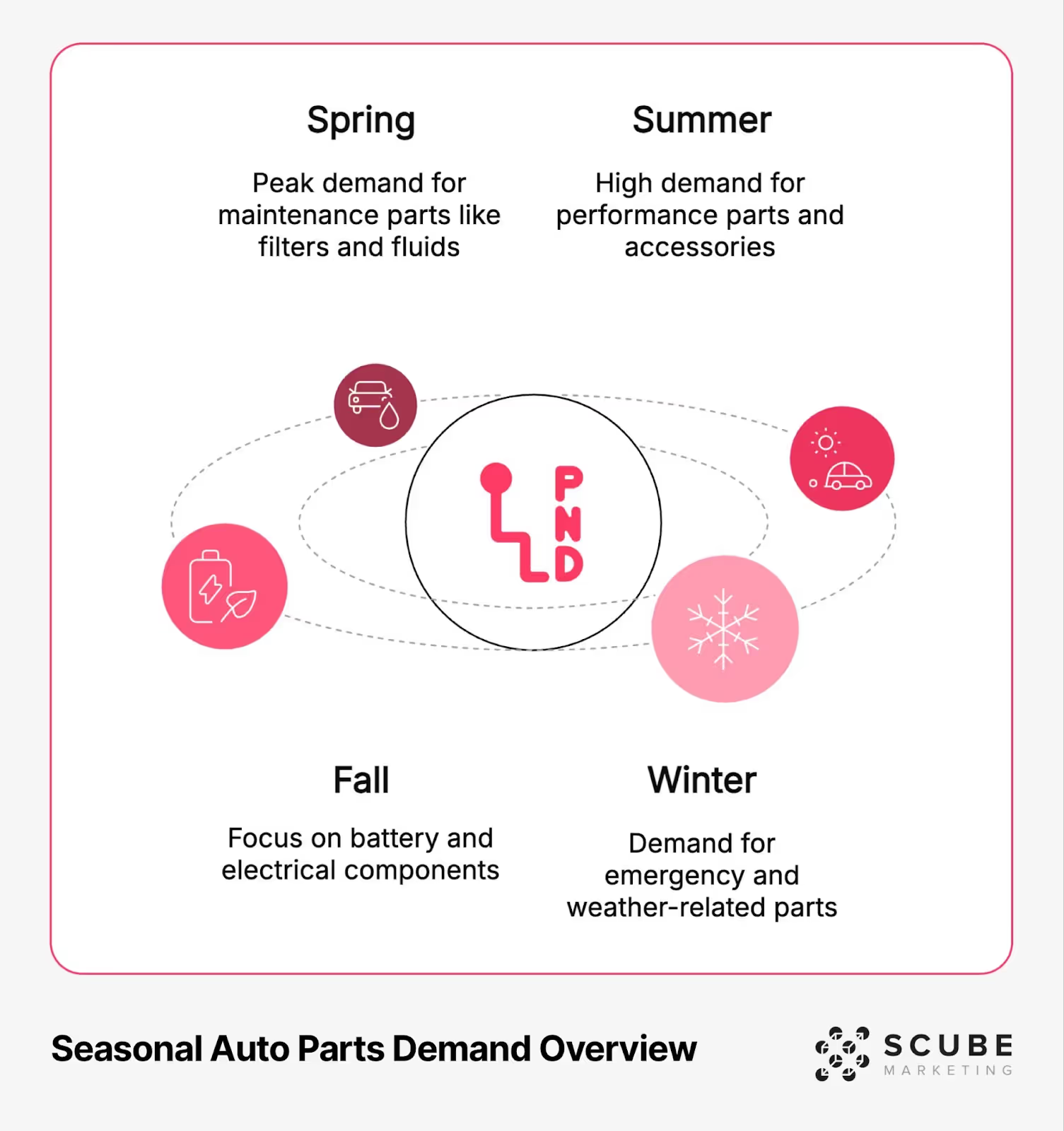
Numbers matter in PPC. As someone who manages Google Ads campaigns for auto parts retailers daily, I've seen firsthand how ROAS (Return on Ad Spend) can make or break a business in this competitive space. The difference between a 3x and 6x ROAS can mean thriving or barely surviving.
But here's the thing about automotive parts advertising – it's uniquely challenging. You're dealing with fitment issues, technically savvy customers, and razor-thin margins. Plus, you're competing against giants like Amazon who can afford to play the long game.
In this post, I'll share what actually works for maximizing ROAS in automotive parts campaigns. No fluff, just data-backed strategies I've seen succeed. Let's get practical.
ROAS matters more than ever. Unlike selling fashion or household items, auto parts retailers face unique challenges that make ROAS particularly crucial.
For those new to this metric, ROAS represents the revenue generated for every dollar spent on advertising. A 6:1 ROAS means you're making $6 for every $1 spent on ads. Sounds simple, but there's nuance in the auto parts world.
Why does ROAS matter more than other metrics for auto parts retailers? Three key reasons:
I see many auto parts retailers obsessing over CPA (Cost Per Acquisition) while ignoring ROAS. This misses the bigger picture. A campaign might have a great CPA but terrible ROAS if it's only selling low-margin items.
Let's look at what good actually looks like in this industry.

Before optimizing, you need context. How does your ROAS compare to industry standards? Let's look at the current benchmarks based on recent data.
When analyzing performance across various campaign types, we see significant differences in ROAS potential. The median Google Ads ROAS for automotive parts currently stands at 6.12, providing a solid benchmark for your campaigns. (Source: Varos)
These numbers tell an interesting story. Search campaigns currently deliver the highest ROAS but are trending downward. Meanwhile, Performance Max campaigns show improvement, suggesting a potential shift in effectiveness.
For context, adjacent categories like car accessories show a ROAS of 4.13, suggesting automotive parts generally perform better in terms of advertising efficiency. (Source: Varos Car Accessories Benchmarks)
What's your ROAS target? For most of my auto parts clients, we aim for 4x minimum to maintain profitability, with 6x+ considered excellent performance.
Several critical factors impact your ROAS performance in the automotive parts space. Understanding these will help you make informed optimization decisions.
The cost structure in automotive advertising creates unique challenges. Auto parts retailers face higher costs compared to many other industries, with the average cost per click for automotive service and parts standing at $3.06. (Source: MegaDigital)
The good news? Auto parts/services enjoy a healthy 12.61% conversion rate, significantly higher than the dealership rate of 7.01%. This higher conversion efficiency helps explain the stronger ROAS performance.
Beyond these metrics, three additional factors heavily influence ROAS in this sector:
The compatibility issue can't be overstated. When someone searches for "Honda Civic brake pads," they need parts that fit their specific year and model. Incompatible clicks waste budget and tank ROAS.
The solution? Compatibility quizzes in your ads can reduce unqualified clicks significantly. This approach works especially well considering 66% of auto ads already use call extensions to provide more information upfront.

Auto parts sales follow predictable seasonal patterns. Understanding these can help you adjust bids and budgets accordingly:
Aligning your bidding strategy with these patterns prevents overspending during low-demand periods and capitalizes on high-demand windows.
Not all auto parts carry the same profit margin or order value. Performance parts typically bring higher margins than maintenance items. Your ROAS targets should reflect these differences.
Smart retailers set different ROAS goals by product category rather than using a one-size-fits-all approach.
Each campaign type offers distinct advantages and challenges for auto parts advertising. Let's analyze their ROAS performance and optimization opportunities.
The auto industry clickthrough rate averages 4.00% for search ads, but high-performing agencies achieve 11.41% CTR (30% above the industry average). This significant performance gap shows the potential for improvement. (Source: StoreGrowers)
Search campaigns deliver the highest ROAS (7.25) because they capture high-intent shoppers who know exactly what they need. These customers have already done their research and are ready to buy.
For maximum ROAS, focus on these search campaign elements:
Shopping campaigns struggle with the lowest ROAS (3.91) primarily due to compatibility issues. When shoppers see a part without confirming fitment, they often click, verify incompatibility, then leave – wasting your ad spend.
Shopping campaigns typically showing lower ROAS compared to search campaigns requires focused optimization efforts. To improve shopping campaign ROAS:
When setting up your automotive parts campaigns, be sure to implement a strategic Google Shopping bidding strategy to maximize your returns. This includes tailoring bids by product category, ROAS potential, and seasonal demand.
Performance Max shows promising results with a 7.07 ROAS and positive momentum (+1.41% MoM). These campaigns leverage Google's machine learning to find customers across all Google properties.
To maximize Performance Max ROAS for auto parts:
Create highly specific asset groups organized by product category and compatibility. Feed the algorithm with strong audience signals from your first-party data. Regularly review performance and adjust assets based on data.
Understanding your competitors helps contextualize your ROAS goals and identify market opportunities. The auto parts advertising space is dominated by major players with significant resources.
In terms of click share, Amazon leads the pack with 16.2% of all automotive parts clicks, followed closely by AutoZone at 14.51% and Advance Auto Parts at 12.93%. (Source: Adthena)
What does this mean for your ROAS? Competing directly against these giants on generic terms will likely result in higher CPCs and lower ROAS. Instead, consider these approaches:
Focus on specialized niches where the big players have less inventory depth. Target enthusiast communities with specific marketing messages. Emphasize your expertise and specialized knowledge in ad copy.
Understanding the nuances of aftermarket auto parts marketing strategies can give you an edge over competitors who take a one-size-fits-all approach to advertising.
Now for the part you've been waiting for – specific tactics to boost your ROAS. These strategies are based on what actually works in the auto parts industry.
Poor product data is the #1 ROAS killer for auto parts retailers. Your feed needs to be immaculate:
Include comprehensive fitment data in titles and descriptions. Use GTINs, MPNs, and brand information for better matching. Add vehicle compatibility lists in structured data. Update inventory and pricing at least daily.
What value-based bidding techniques work best for maximizing ROAS is a question many auto parts retailers ask us. The answer depends on your specific business model, but generally:
Set different target ROAS values by product category based on margins. Use tROAS bidding once you have sufficient conversion data. Implement portfolio bidding across related campaigns.
Auto parts searches are notoriously specific. A robust negative keyword strategy prevents wasted spend:
Exclude DIY terms for high-complexity parts (if you target professionals). Block irrelevant vehicle makes/models for specialized parts. Eliminate rental, lease, and dealership terms if you sell only to end consumers.
More auto parts research happens on mobile than desktop, but many advertisers fail to optimize for this:
Create mobile-specific ads that load quickly and get to the point. Use call extensions for immediate customer support. Segment campaigns by device to bid appropriately.
Continuous testing drives incremental ROAS improvements:
Test different ad formats (text vs. responsive). Compare standard shopping vs. showcase shopping ads. Evaluate various extension combinations. Experiment with landing page layouts focused on compatibility verification.
Proper measurement is essential for accurate ROAS calculation and optimization. Many auto parts retailers make critical mistakes here.
Auto parts purchases often involve multiple touchpoints. A customer might research on mobile, check compatibility on your site, then purchase on desktop days later.
To address this, implement these advanced measurement approaches:
Use data-driven attribution models rather than last-click. Set appropriate lookback windows (30+ days recommended for auto parts). Connect online ad engagement to in-store purchases when applicable.
Effective ROAS monitoring requires good visualization. Create dashboards that show:
ROAS analysis should inform your broader strategy. Shopping ads now drive 75% of U.S. retail search ad spend, highlighting their importance despite lower ROAS in the auto parts sector. (Source: WebFX)
Consider this context when allocating your overall marketing budget. Sometimes maintaining presence in lower-ROAS channels supports your higher-ROAS channels through awareness and consideration effects.

Mastering ROAS for automotive parts requires both technical expertise and industry-specific knowledge. The benchmarks and strategies outlined here provide a roadmap, but constant testing and optimization remain essential.
Remember these key points:
Search campaigns currently deliver the highest ROAS (7.25). Performance Max shows promising growth (+1.41% MoM). Shopping campaigns need the most optimization due to lower ROAS (3.91).
Focus on what you can control: immaculate product data, smart bidding strategies, comprehensive negative keywords, and proper attribution. These fundamentals drive meaningful ROAS improvements over time.
What's your experience with ROAS in the automotive parts industry? Have you found certain strategies particularly effective? I'd love to hear your thoughts in the comments.
Until next time,
Tom